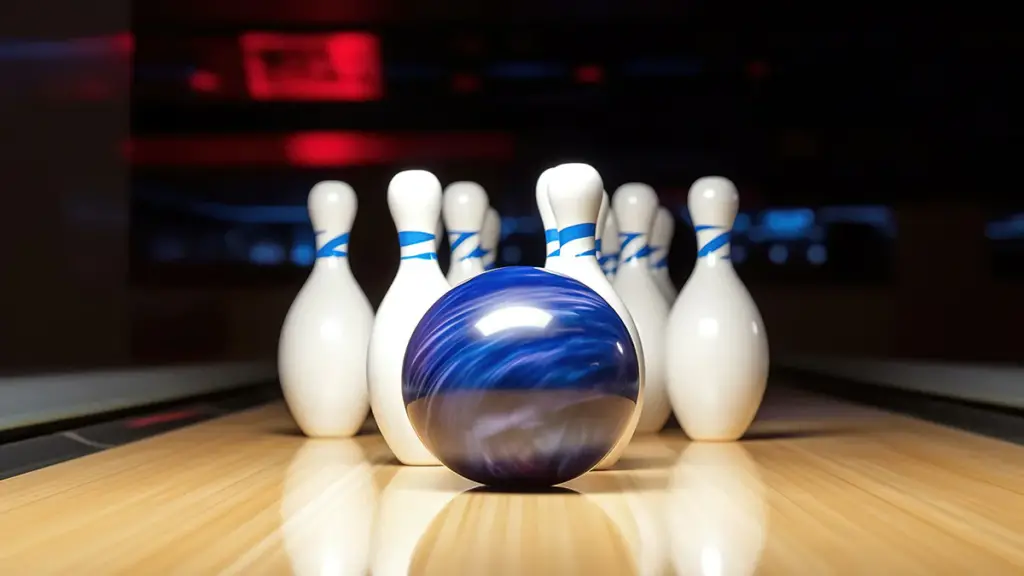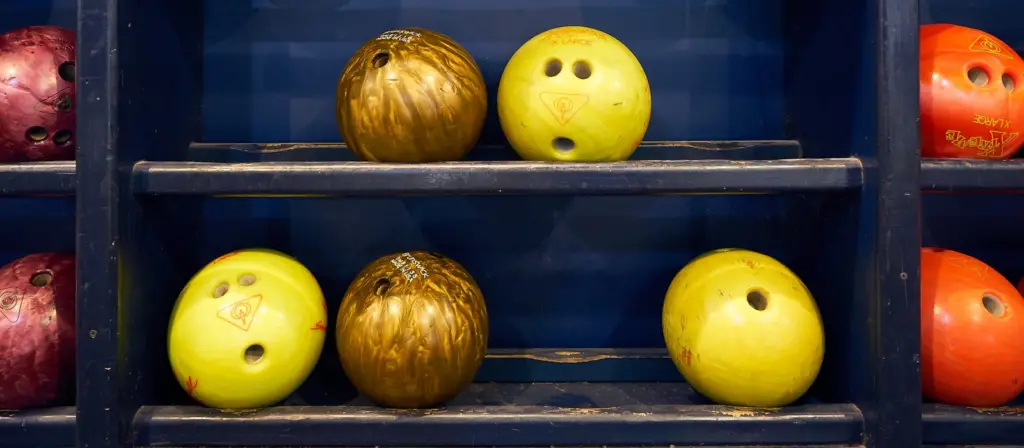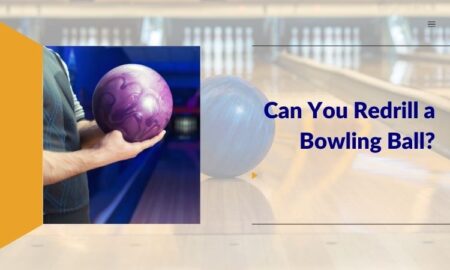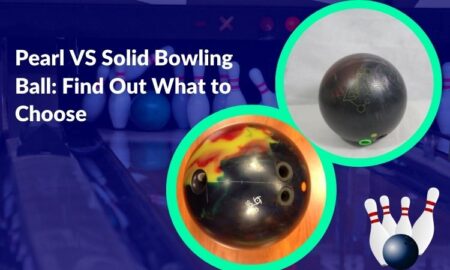Pearl and solid bowling balls differ in their surface composition. Pearl have coverstocks made with mica or resin material whereas solid bowling balls have base coverstock with numerous microscopic reactive pores. Due to its surface, solid balls tend to hook earlier and that’s why is it best to use earlier when the oil is fresh. However, the pearl bowling ball due to its late hook is better when the lane condition is worn out.
These are some of the key differences between pearl ball and solid ball. If you want to know more about these bowling balls and when to consider them then keep reading this article.
Pearl VS Solid Bowling Ball: Quick Review
The following table shows the difference between a Pearl and a Solid Bowling Ball.
| Factors | Pearl Bowling Ball | Solid Bowling Ball |
| Surface Composition | Coverstocks with mica material | Base coverstock with numerous microscopic reactive pores |
| Friction Coefficient | Lower Friction Coefficient | Higher Friction Coefficient |
| Hook Characteristics | Late Hook | Early Hook |
| When to Use | Later | Earlier |
| Lane Condition Consideration | Better for Worn Lane Condition | Better for Fresh Oil Conditions |
| Cost Range | $90 – $220 | $90 – $180 |
As you can see there is a significant difference in their surface. Now let’s delve into the detailed discussion between them.
Pearl VS Solid Bowling Ball: Detailed Comparison
Let’s get into the details of finding the best choice between Pearl and Solid Bowling Ball.
Surface Composition:
The solid reactive ball coverstocks have numerous microscopic reactive pores on the surface. But Pearl reactive coverstocks use mica material which extends the ball’s reaction on dry lanes.
Normally, solid bowling balls have base coverstock which has high friction in the oil. Along with this, it has a sanded factory finish for increased traction on the oil. Although there is no specific core for solid bowling balls and this difference can affect its angularity and the overall ball reaction.
Pearl bowling balls have additives like resin or mica particles in them. These additives lead it to extend ball reaction on dry lanes which enables a skid motion in the front end and stores energy for a potent back-end hook.
Friction Coefficient:
Solid bowling balls have a higher coefficient of friction than Pearl Bowling Balls. Due to this higher friction coefficient, the solid balls hook sooner on the lane.
Solid reactive bowling balls skid less on the front end. But pearl balls due to their lower friction coefficient skids more on the front end before showcasing a sharper reaction from the break point to the pocket.
Bonus: Read this article to find which one is the best bowling ball for beginners.
Hook Characteristics:
Solid reactive balls tend to hook earlier than pearl bowling balls. This is why solid balls have less energy loss and display a less sharp break point on their dry lanes.
The solid ball’s early hook is a plus point for fresh oil conditions. This ensures a consistent pocket entry. But pearl reactive balls, with their lower friction coefficient, deliver a longer skid motion in the front end before making a sharper turn on the back end.
This makes the pearl balls more effective later in the day when a solid ball might hook too early. Hence, the pearl ball covers more distance before its decisive move.
When to Use:
Solid balls are preferable when the oil is fresh, making them suitable for an early start and consistent pocket entry. In contrast, pearl balls come into play later in the day when a solid ball may hook too early.

The early hooking characteristics of a solid ball ensure a reliable path to the pocket. Whereas, the extended skid motion of pearl balls is advantageous when the lane conditions have undergone wear, allowing the ball to cover more distance before executing a sharp turn.
Bonus: Check this comparison between Motiv and Storm Heavy Oil Balls.
Prominent Pearl and Solid Bowling Balls:
Understandably, there are some good quality pearl and solid bowling balls in the market.
The following table shows some of the best Pearl Bowling Balls available.
| Product Name | Feature | Price |
| Storm Hy-Road Pearl | Grape Punch Fragrance Reacta Gloss Factory Finish Pearl Reactive Coverstock No Core | Check Price |
| 900 Global Zen Bowling Ball | S77 Response Pearl Coverstock Reacta Gloss Factory Finish Symmetrical Weight block Light Weight Core | Check Price |
| Motiv Fatal Venom | Infusion™ Pearl Reactive Coverstock Gear™ Symmetric Weight Block 5500 Grit LSP Finish | Check Price |
| Hammer Black Widow Ghost Pearl | Gas Mask Core 500, 1000, 1500 Siaair / Crown Factory Compound Finish Aggression Pearl Coverstock | Check Price |
| Storm Tropical Surge Pink/Purple | Birthday Cake Fragrance 500-grit Polished Finish Perfect for Light to Medium Oil Lane Conditions | Check Price |
Now let’s check some of the best Solid Bowling Balls.
| Product Name | Feature | Price |
| Storm Phaze II Bowling Ball | Reactive-Solid Outer MaterialRed Velvet Cake FragranceTX-16 CoverstockLight Weight Core | Check Price |
| Motiv Venom Shock | Turmoil™ MFS Solid Reactive Coverstock4000 Grit LSS FinishGear™ Symmetric Weight Block | Check Price |
| Storm IQ Tour | Red Apple Crisp Fragrance4000 Grit LSS FinishR2S Coverstock | Check Price |
| Raw Hammer | Juiced Solid CoverstockPerfect for Medium Oil Lane Condition500, 1500, 3000 Siaair Micro Pad FinishSymmetric Core Type | Check Price |
| Hustle Camo | Perfect for Light to Medium Oil Lane ConditionsReact Gloss Factory FinishSymmetrical Weight block | Check Price |
Which One to Choose Between a Pearl and a Solid Bowling Ball?
Choosing between solid and pearl bowling balls depends on various factors, each catering to specific preferences and playing conditions.
If you’re bowling on freshly oiled lanes, a solid reactive bowling ball is your go-to choice. These balls, with their higher friction coefficient and early hooking characteristics, provide a smoother, more arc-like motion.
This early hook ensures a reliable path to the pocket, making it easier to consistently hit your target. So, if you’re one of the first on the lanes, a solid ball is your ideal companion.

As the day progresses, or if the lane conditions have undergone wear, the pearl reactive bowling ball comes into play. With a lower friction coefficient, pearl balls offer an extended skid motion in the front end before making a sharper turn on the back end.
This characteristic is advantageous when a solid ball might hook too early. If you find yourself bowling in the later hours or on lanes with less oil, the pearl ball can cover more distance before executing its decisive move.
For bowlers in the 130-180 average range, owning both solid and pearl reactive balls provides adaptability to varying oil conditions during play. Highly skilled players averaging 180-200 are encouraged to invest in multiple bowling balls, including both solid and pearl reactive coverstocks, for a versatile arsenal.
It’s essential to consider additional insights beyond the primary factors. Coverstock formulas vary between brands, affecting ball reactions, and understanding both coverstock and core design is crucial for specific ball comparisons.
Make sure to consult with a pro-shop operator based on your playing style so that you can get personalized advice. Along with this, watch informative videos comparing solid and pearl covers that can enhance your decision-making process.
Frequently Asked Questions (FAQs):
What is a Solid Bowling Ball?
A solid bowling ball falls under the category of reactive bowling balls. It is characterized by a solid coverstock featuring microscopic reactive pores on the ball’s surface. The solid coverstock is available in various finishes, including polished, sanded, and buffed with a rubbing compound.
What Does Pearl Mean in Bowling?
In bowling, when we talk about a “pearl,” we’re talking about a specific kind of cover on a bowling ball. This cover has some extra stuff in it, like mica, which makes it behave differently. Pearl bowling balls can react fast when they encounter the sticky parts of the lane.
What is a Weaker Bowling Ball?
A weaker bowling ball is commonly associated with a coverstock that enhances skidding in the initial part of the lane before initiating a reaction. This quality proves beneficial in drier lane conditions.
Conclusion
In conclusion, between pearl and solid bowling balls, the choice difference depends on your bowling requirement and how long are you going to bowl. Make sure to consider that before you choose between the two. Finally, you can also consult a pro-shop operator or a store owner before you make the final decision.



![Urethane Vs Reactive Resin [Choose the best Bowling Ball]](https://bowlingroller.com/wp-content/uploads/urethane-vs-reactive-resin-450x270.jpg)




